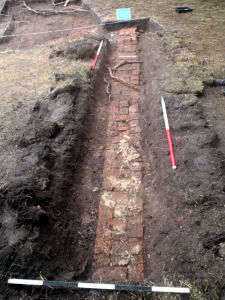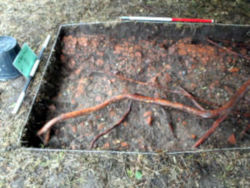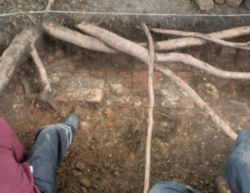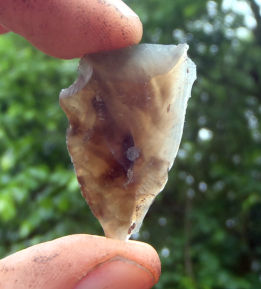30 May 2018
Forty Hall Spring Dig - Day 3

Having dried ourselves out following the soggy conclusion to yesterday's digging, our hardy team were rewarded for braving the elements today, with plenty of Tudor palace archaeology as well as some fantastic small finds.
To simplify our search for the junction of the North-South wall we've been studying, and last year's substantial drain to the north, and also to clarify some features we saw in a small test pit nearby in 2012, we opened a long thin trench extension to trace the line of the very shallowly buried wall as it approaches trench 2.
The wall is very well preserved, although the quality of construction varies quite a bit along its length, suggesting this maybe wasn't the best quality bricklaying the 16th century had to offer!
The deposits in trench 2 continued to show considerable signs of tree root and possibly planting pit disturbance, but a small preview slot cut late in the day revealed the top of the sought-after drain, so now revealing it and its connection with the north-south wall should (hopefully!) be fairly straightforward (weather permitting).

Trench 1, having been thoroughly cleaned by the rain overnight, was photographed and recorded early in the day and we began to remove the rubble deposit, soon confirming that the line of rubble running along one side of the trench is indeed on top of the expected wall of the 'barn' structure we are looking for.
There's more work to do to reveal the wall along the full length of the trench, but its construction looks very much as we expected -- a 'dwarf' wall which would have supported a timber-framed structure with evidence in the rubble for a possibly mixed tile and slate roof.

There have also been a number of deliberately dressed flints come from this trench, which suggests their (probably partially decorative) use in a wall, either in this building or somewhere nearby. This method of building is atypical for Elsyng, and we've yet to see any in-situ examples of such work.
The trench has produced a wide range of small finds, from the relatively ubiquitous clay pipe stems to the less common decorated Delft tile fragments, a broad range of pottery, as well as some pieces of glazed floor tiles, which, as we often find, showed signs of considerable wear and tear -- an indicator of the dilapidated state of the palace that prompted its final demolition c.1657.

Undoubtedly the star find of the day though, and causing many a heart to flutter, was an object that had nothing to do with the palace at all: A beautiful and still extremely sharp Mesolithic arrowhead.
The Mesolithic period, spanning roughly 8,000 to 12,000 b.c., was a time when people were living predominantly as nomadic hunter-gatherers, and is a very sparsely recorded period indeed in Enfield.
The arrowhead is a gorgeous example of a "tranchet" type -- a triangular shape that would have been fixed to an arrow shaft by the narrow point, presenting the lethally sharp chisel-like end, which was designed to sever as many major blood vessels as possible on impact.
It's hard to think of a more evocative object; one that connects its holder with a fellow human being who lived and died more than ten thousand years before Henry VIII first arrived on the scene, or a more appropriate one for the site of what was once the headquarters of Henry's hunting forest of the Royal Chase.
Tomorrow's forecast doesn't look good and if the heavens open early in the morning we may make a delayed start. Thanks to today's finds we've plenty of motivation to crack on, though!